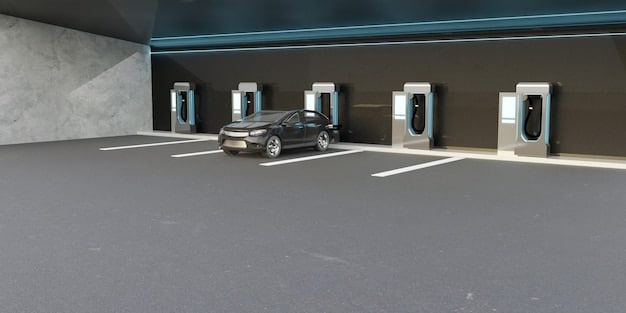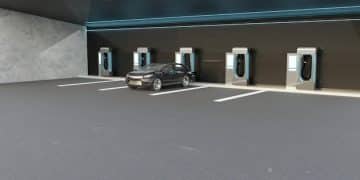Electric Vehicle Charging Infrastructure Market Growth: US Predictions

The latest predictions for the growth of the electric vehicle charging infrastructure market in the US indicate a significant expansion driven by increasing EV adoption, government incentives, and private investments, projecting substantial growth in charging stations and technological advancements.
The future of electric vehicles (EVs) in the US hinges significantly on the development and expansion of its charging infrastructure. Understanding the latest predictions for the growth of the electric vehicle charging infrastructure market in the US is crucial for investors, policymakers, and consumers alike. This article delves into the key trends, forecasts, and factors shaping this rapidly evolving landscape.
Decoding the US Electric Vehicle Charging Infrastructure Market
The **electric vehicle charging infrastructure market in the US** is experiencing unprecedented growth. This expansion is fueled by a combination of factors, including increasing consumer adoption of EVs, supportive government policies, and substantial investments from both public and private sectors. Understanding the dynamics of this market requires a closer look at the current state and future projections.
Several market research firms and industry analysts have provided insights into the anticipated growth trajectory. These predictions help stakeholders prepare for the challenges and opportunities that lie ahead, ensuring a smoother transition to electric mobility.

Key Growth Drivers
The growth of the EV charging infrastructure market is not a monolithic phenomenon. Several key drivers are contributing to its expansion:
- Increasing EV Adoption: As more consumers switch to electric vehicles, the demand for accessible and reliable charging infrastructure grows proportionally.
- Government Incentives: Federal, state, and local governments are offering incentives, such as tax credits and grants, to encourage the deployment of EV charging stations.
- Private Investments: Numerous companies are investing heavily in the development and deployment of charging infrastructure, recognizing the market’s potential.
- Technological Advancements: Innovations in charging technology, such as faster charging speeds and wireless charging, are making EV ownership more convenient and appealing.
These factors collectively create a conducive environment for growth, setting the stage for a robust and expanding EV charging infrastructure market in the US.
In conclusion, the US electric vehicle charging infrastructure market is poised for substantial growth, propelled by increasing EV adoption, government incentives, private investments, and technological advancements. Staying informed about these drivers is key to understanding the market’s potential and navigating its complexities.
Forecasting the Future: Key Predictions for the Next Decade
Looking ahead, the **electric vehicle charging infrastructure market in the US** is expected to undergo significant changes and expansion. Several forecasts provide insights into the anticipated growth rates, technological advancements, and market trends that will shape the industry over the next decade.
These predictions are based on various factors, including current market trends, anticipated policy changes, and technological breakthroughs. By examining these forecasts, stakeholders can gain a better understanding of the opportunities and challenges that lie ahead.
Growth Rate Projections
Market analysts predict substantial growth in the number of EV charging stations across the US. According to various reports, the market is expected to grow at a compound annual growth rate (CAGR) of between 25% and 35% over the next decade. This growth will be driven by the need to support the increasing number of EVs on the road.
The deployment of charging stations will not be uniform across the country. Areas with high EV adoption rates, such as California, Washington, and Florida, are expected to see the most significant growth. However, efforts are also underway to expand charging infrastructure in underserved communities and rural areas.

- Increased Charging Station Density: Expect to see more charging stations in urban and suburban areas to meet growing demand.
- Expansion in Rural Areas: Initiatives are underway to expand charging infrastructure in rural areas to support long-distance EV travel.
- Emphasis on Fast Charging: The deployment of DC fast chargers (DCFCs) will accelerate to reduce charging times and improve convenience.
Overall, the next decade promises significant growth and expansion in the electric vehicle charging infrastructure market, driven by the need to support the increasing number of EVs on the road and enhance the convenience of electric mobility.
In summary, the future of the electric vehicle charging infrastructure market in the US looks promising, with significant growth expected in the coming decade. These predictions highlight the opportunities and challenges that lie ahead, emphasizing the importance of strategic planning and innovation in the industry.
The Role of Government Policies and Incentives
Government policies and incentives play a crucial role in shaping the **electric vehicle charging infrastructure market in the US**. Federal, state, and local governments are implementing various measures to encourage the deployment of EV charging stations and promote the adoption of electric vehicles.
These policies and incentives not only stimulate market growth but also help address some of the key barriers to EV adoption, such as range anxiety and the high upfront cost of EVs. By understanding the impact of these government initiatives, stakeholders can better navigate the market and make informed decisions.
Federal Initiatives
At the federal level, several initiatives are underway to support the growth of the EV charging infrastructure market. The Bipartisan Infrastructure Law, for example, includes significant funding for the deployment of EV charging stations across the country. This funding is being used to establish a national network of charging stations, with a focus on deploying fast chargers along major highways.
Additionally, the federal government offers tax credits for the purchase of EVs and the installation of charging stations. These tax credits help reduce the cost of EV ownership and make charging infrastructure more accessible to businesses and individuals.
State and local governments are also implementing various policies and incentives to promote EV adoption and charging infrastructure development. These include rebates for EV purchases, grants for charging station installations, and preferential parking for EVs.
Supportive policies and financial incentives significantly boost the growth of the EV charging infrastructure market in the US. These measures encourage both consumers and businesses to invest in electric vehicles and charging stations, accelerating the transition to electric mobility.
In conclusion, government policies and incentives are vital drivers of the electric vehicle charging infrastructure market, fostering growth, innovation, and accessibility. These measures play a crucial role in advancing the adoption of electric vehicles and creating a sustainable transportation future.
Technological Innovations in Charging Infrastructure
Technological innovations are transforming the **electric vehicle charging infrastructure market in the US**, making charging faster, more convenient, and more efficient. These advancements are not only enhancing the user experience but also addressing some of the key challenges associated with EV charging, such as long charging times and grid capacity constraints.
By exploring the latest technological developments, stakeholders can gain insights into the future of EV charging and the potential for further innovation. These innovations are crucial for supporting the widespread adoption of electric vehicles and creating a seamless charging experience.
Faster Charging Technologies
One of the most significant advancements in EV charging technology is the development of faster charging solutions. DC fast chargers (DCFCs) are now capable of delivering significantly higher power levels, reducing charging times from several hours to just a few minutes. This is particularly important for long-distance travel and for drivers who need to quickly recharge their vehicles.
In addition to faster charging speeds, wireless charging technology is also gaining traction. Wireless charging allows EVs to be charged without the need for cables, providing a more convenient and user-friendly charging experience. While still in its early stages, wireless charging has the potential to become a mainstream charging option in the future.
Smart charging solutions are also playing an increasingly important role in managing the demand for electricity. Smart charging systems can optimize charging schedules to reduce strain on the grid and take advantage of off-peak electricity rates. This helps ensure that the grid can handle the increased demand from EVs without experiencing blackouts or brownouts.
- DC Fast Chargers (DCFCs): Significantly reduce charging times, making EV ownership more convenient for long trips.
- Wireless Charging: Offers a cable-free charging experience, enhancing usability and convenience.
- Smart Charging Systems: Optimize charging schedules to reduce grid strain and take advantage of off-peak electricity rates.
Overall, the technological innovations in EV charging infrastructure are driving improvements in speed, convenience and efficiency. These advancements are essential for supporting the growth of the electric vehicle market and creating a sustainable transportation future.
In summary, technological innovations are revolutionizing the electric vehicle charging infrastructure market in the US, enhancing the user experience and addressing key challenges. These advances are essential for promoting the widespread adoption of electric vehicles and creating a more sustainable transportation system.
The Competitive Landscape: Major Players and Market Dynamics
The **electric vehicle charging infrastructure market in the US** is becoming increasingly competitive, with a growing number of companies vying for market share. These players include established energy companies, automotive manufacturers, technology startups, and infrastructure providers. Understanding the competitive landscape is crucial for assessing market dynamics and identifying opportunities for growth.
The market is characterized by a mix of public and private sector participants, each with their own strengths and strategies. By examining the major players and their approaches, stakeholders can gain a better understanding of the competitive forces shaping the industry.
Key Players in the Market
Several major players are driving the growth of the EV charging infrastructure market in the US. These companies are deploying charging stations, developing new technologies, and forging partnerships to expand their reach. Some of the key players include:
Tesla: As a leading electric vehicle manufacturer, Tesla has invested heavily in its Supercharger network, providing fast charging for Tesla owners across the country.
ChargePoint: ChargePoint operates one of the largest networks of EV charging stations in the US, offering a variety of charging solutions for homes, businesses, and public locations.
Electrify America: Electrify America is investing billions of dollars in the deployment of DC fast chargers along major highways, aiming to create a comprehensive charging network for long-distance EV travel.
EVgo: EVgo focuses on providing fast charging solutions in urban areas, targeting drivers who need to quickly recharge their vehicles while on the go.
- Tesla: Emphasizes proprietary technology and a closed ecosystem, focusing on Tesla owners.
- ChargePoint: Offers a broad range of charging solutions and network services for diverse customers.
- Electrify America: Concentrates on high-power fast charging along major transportation corridors.
These dynamics significantly influence the direction of the EV charging infrastructure market in the US. Competition drives innovation, lowers prices, and improves the availability of charging options. This ultimately benefits EV owners and encourages further adoption of electric vehicles.
In conclusion, the competitive landscape of the electric vehicle charging infrastructure market in the US is dynamic and evolving, with a mix of established players and emerging startups. Competition is driving innovation, expanding infrastructure, and improving the overall charging experience for EV owners.
Overcoming Challenges and Barriers to Growth
Despite the strong growth potential of the **electric vehicle charging infrastructure market in the US**, several challenges and barriers must be addressed to ensure its continued expansion. These challenges include high infrastructure costs, grid capacity constraints, standardization issues, and permitting delays. Overcoming these obstacles is crucial for unlocking the full potential of the EV charging market.
By understanding the challenges and implementing strategies to mitigate them, stakeholders can pave the way for a more robust and sustainable EV charging ecosystem. This requires collaboration between government, industry, and consumers to address the various roadblocks to growth.
Addressing High Infrastructure Costs
The cost of installing and maintaining EV charging stations can be significant, particularly for DC fast chargers. These high costs can deter businesses and municipalities from investing in charging infrastructure, slowing down the pace of deployment. To address this issue, governments and utilities are offering financial incentives, such as grants and rebates, to help offset the cost of charging station installations.
Another challenge is ensuring that the electricity grid can handle the increased demand from EVs. As more EVs come online, the grid may need to be upgraded to accommodate the additional load. Smart charging solutions and energy storage systems can help manage this demand and prevent blackouts or brownouts.
Standardization of charging protocols and connectors is also essential for ensuring compatibility and interoperability between different vehicles and charging stations. The lack of standardization can create confusion and frustration for EV owners. Industry stakeholders are working to develop common standards that will promote a more seamless charging experience.
- Financial Incentives: Governments and utilities offer grants and rebates to reduce the cost of charging station installations.
- Grid Upgrades: Investments in grid infrastructure are needed to accommodate the increased demand from EVs.
- Standardization: Industry stakeholders are working to develop common charging standards and protocols.
Addressing these challenges and barriers is crucial for the continued growth of the EV charging infrastructure market in the US. Collaboration between government, industry, and consumers is essential for creating a robust and sustainable EV charging ecosystem.
In summary, the electric vehicle charging infrastructure market in the US faces several challenges, including high infrastructure costs, grid capacity constraints, and standardization issues. Overcoming these barriers requires collaboration and innovation to ensure a smooth transition to electric mobility.
| Key Point | Brief Description |
|---|---|
| 📈 Growth Rate | Market expected to grow at a CAGR of 25%-35% in next decade. |
| ⚡ Tech Innovations | Faster charging (DCFC), wireless charging, and smart charging solutions. |
| 🏛️ Gov. Support | Incentives like the Bipartisan Infrastructure Law and tax credits. |
| 🚧 Challenges | High costs, grid constraints, and standardization issues. |
Frequently Asked Questions
▼
The market is predicted to grow at a compound annual growth rate (CAGR) of between 25% and 35% over the next decade, driven by increasing EV adoption and supportive government policies.
▼
Key drivers include increasing EV adoption, government incentives and policies, private investments in charging infrastructure, and technological advancements in charging technology.
▼
Government policies and incentives, such as tax credits, grants, and funding from the Bipartisan Infrastructure Law, significantly encourage the deployment of EV charging stations.
▼
Innovations include faster charging technologies like DC fast chargers (DCFCs), wireless charging, and smart charging systems that optimize charging schedules to reduce grid strain.
▼
Key challenges include high infrastructure costs, grid capacity constraints, standardization issues related to charging protocols, and permitting delays for charging station installations.
Conclusion
In conclusion, the electric vehicle charging infrastructure market in the US is on a trajectory of significant growth, driven by a confluence of factors including increasing EV adoption rates, supportive government policies, technological innovations, and robust private investments. While challenges such as high infrastructure costs and grid capacity limitations remain, the overall outlook for the market is exceedingly positive, suggesting a future where electric mobility becomes increasingly accessible and convenient for all Americans.





